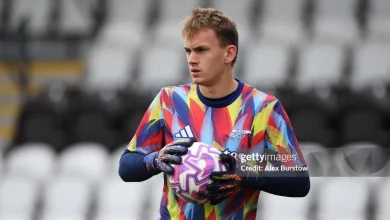Lionel Messi is still remarkable – these stats, visuals and data prove it – The Athletic

Lionel Messi is having himself a party in the United States.
And that will continue after he signed a contract extension at Inter Miami this week, which will keep the 38-year-old at the MLS club until the end of 2028.
He won the Landon Donovan MVP award in 2024, scoring 20 goals and setting up 16, as Miami topped the Eastern Conference for the first time — though Atlanta United then knocked them out in the playoffs that decide the season’s champions.
This year is set to be even better.
Messi finished the regular season as top scorer with 29 goals, his most in a league campaign since 2018-19 at Barcelona.
Miami finished third in the Eastern Conference this time, though just a point behind leaders Philadelphia Union. They face Nashville in a best-of-three tie in the first round of the playoffs beginning this weekend — a team they beat home and away in the regular season, including a 5-2 final-day smashing, when Messi netted a hat-trick.
Messi’s move to MLS from Paris Saint-Germain in 2023 might have looked like the start of his career twilight then, but he’s sticking around. And he might not make Ballon d’Or shortlists anymore, but Messi is still Messi.
On the back of his new contract, The Athletic has taken a look at the standout stats that tell you what you need to know about the Argentina superstar.
Getting the Barcelona band back together
The arrivals of Sergio Busquets and Jordi Alba in that same summer two years ago, and Luis Suarez the following year, were a galacticos-style approach to Miami trying to ensure they’d get the best out of Messi — bringing in three of his former Barcelona team-mates, with whom he had excellent partnerships.
It has paid off in 2025, with that trio being the top three chance creators for Messi.
Busquets was the creator-in-chief.
There were a few ‘assists’ which resembled their Barcelona days, where he would lay the ball off to Messi, and a mazy dribble or long-distance goal followed. Mainly, though, the Spanish midfielder delivered through balls against organised defences — naturally, opponents tend to mark Messi tightly, inadvertently leaving space in behind for him to run into.
His eight goals from through balls in 2025 were the most in MLS, and more than any player in Europe’s top five domestic leagues.
Busquets to Messi was the joint-most fruitful attacking combination (six goals), tied with Emil Forsberg to Eric-Maxim Choupo-Moting at fellow MLS side New York Red Bulls.
There were intricate combinations between Messi and striker Suarez, with the pair’s technical quality more than compensating for any age-related physical shortcomings. Left-back Alba assisted the Argentina international on five occasions, for a range of goals: balls in-behind from deep, vertical passes slid between defenders from the edge of the box, and low back-post crosses.
Work-of-art touchmaps
Miami won six of their final eight regular-season matches, peaking late when the pressure was on — they had four games in hand and a nine-point gap to make up on Philadelphia as of September 14.
Messi came up clutch when it counted, scoring 10 goals and assisting nine in the last eight fixtures, netting three match-winners (vs Atlanta, D.C. United and Seattle Sounders) and setting up the winner twice (against New England Revolution and New York City).
Look where he touches the ball. Every match is a variation of the same theme. He rarely, if ever, drops deep, partly because there is sufficient quality in Miami’s midfield to progress the ball to him in the first place, and because he knows where he works best.
There are times when he takes aim from range more, such as against D.C., Chicago Fire and New England. If he is running into the box, it’s almost always to shoot.
The range of finishes he scores with rarely comes up in discussions, and it should.
Carrying the team
Over the past two seasons, Miami have been one of the most electric attacking teams in MLS history. They scored 79 times in the 2024 regular season, and bettered that with 81 this year, a total which is almost double what they produced in 2023 (41), the season Messi arrived from Europe halfway through.
There were three 4-1 wins and two each by 4-0 and 5-1 scorelines. Nobody could defend their attacking firepower, with Miami the highest-scoring regular-season MLS team since LAFC hit 85 goals in 2019.
Messi led the league for shots, through balls and big chances created, outperforming his expected goals by more than six. He’s 13 goals over ‘average’ since joining Miami, keeping up the kind of finishing overperformance that has been a through line across his career.
The best part? He didn’t score from inside the six-yard box at all, and only had five shots from that close. Messi has made the deeper parts of the pitch his creative space — 44 through balls — and picks out the corners from the edge of the box.
When Messi was not scoring, he was assisting or part of the build-up. Almost 10 Miami shots per game involved him in some capacity.
He has gravity, and that helps the team. Nobody wants to leave Messi isolated, which means he regularly faces double or triple teams, and even defenders tasked with marking other Miami players end up ball-watching him in possession.
Here are two pre-assists, to use an ice hockey term, where Messi helped put Miami ahead this season.
In both, the whole opposing defence is fixated on him, and he spots the run of Alba, releasing his left-back to set up a goal.
He (still) doesn’t defend
The arrival of Rodrigo De Paul in July, on a half-season loan from Atletico Madrid, was a telling one. It is De Paul who made the system work for Argentina at the 2022 World Cup, when Lionel Scaloni — promoted from the South American nation’s age-group teams — coached Messi and company to long-awaited glory.
De Paul was the midfielder with a responsibility to defend for both himself and Messi, allowing the then 35-year-old forward to minimise his running and stay high when Argentina were out of possession.
Javier Mascherano, once a Barcelona and Argentina team-mate of Messi’s and now his head coach at Miami, is using the same tactics: as per data provider SkillCorner, Messi produced the second-lowest running distance and lowest sprint distance of any wide attacker or centre-forward in MLS this season.
His total of 43 defensive actions in 28 appearances (26 starts) is, incredibly, lower than his goals plus assists figure this year.
It’s a reason why Miami are never as defensively watertight as other teams.
But why run when you’re Messi?





